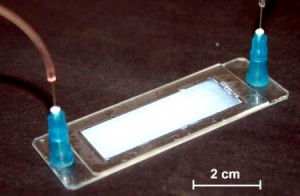High energy costs are one drawback of making clean water from waste effluents. According to an article in the journal Biomicrofluidics, which is published by the American Institute of Physics, a new system that combines two different technologies proposes to break down contaminants using the cheapest possible energy source, sunlight. Microfluidics — transporting water through tiny channels — and photocatalysis — using light to break down impurities — come together in the science of optofluidics.
“These two technologies have been developed in parallel but there have been few efforts to employ the natural synergy between them,” says author Xuming Zhang of the Hong Kong Polytechnic University. “Our results showed a dramatic improvement in the efficiency of the photocatalyst.”
The researchers fabricated a planar microfluidic reactor, or microreactor, which is essentially a rectangular chamber made of two glass plates coated with titanium dioxide, the active ingredient in many sunscreen lotions. On exposure to sunlight, the coating releases electrons that react with contaminants in the water and break them down into harmless substances. This is the photocatalysis part of the process. The high surface area of the microreactor enhances the ability of the catalyst to capture sunlight. Although the gap between plates is small, Zhang plans to expand the rectangular dimensions to two square meters. “Our current small-scale proves the concept but we are also scaling up the reactor to a throughput of 1,000 liter per hour,” he says. If the larger reactor proves effective, many parallel devices might be used to handle industrial water treatment applications.
Source: http://www.sciencedaily.com


